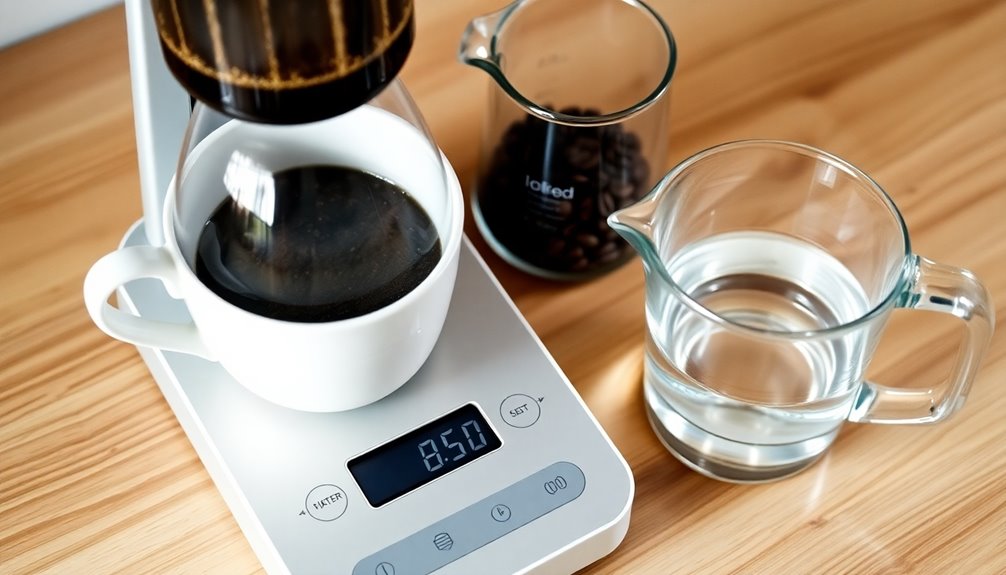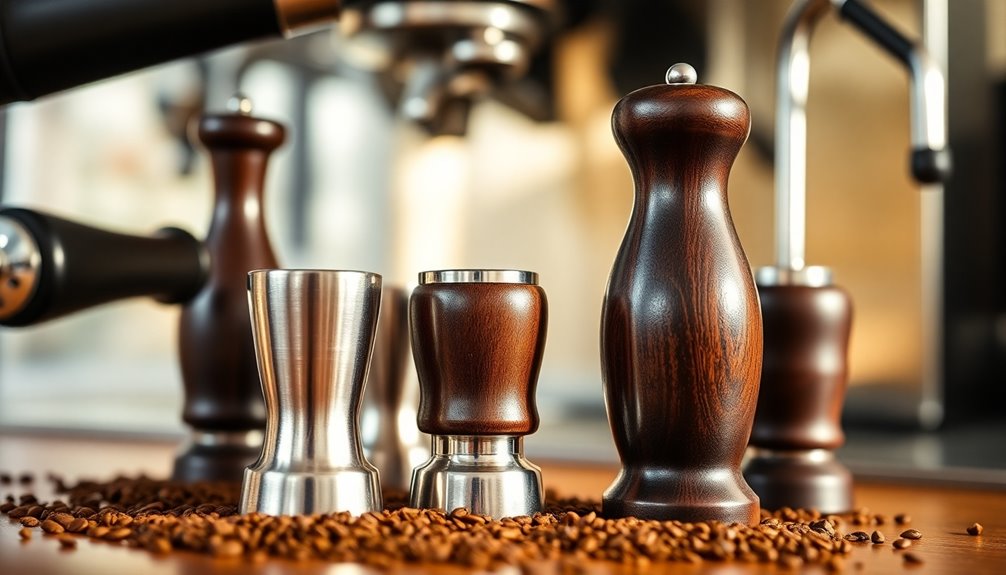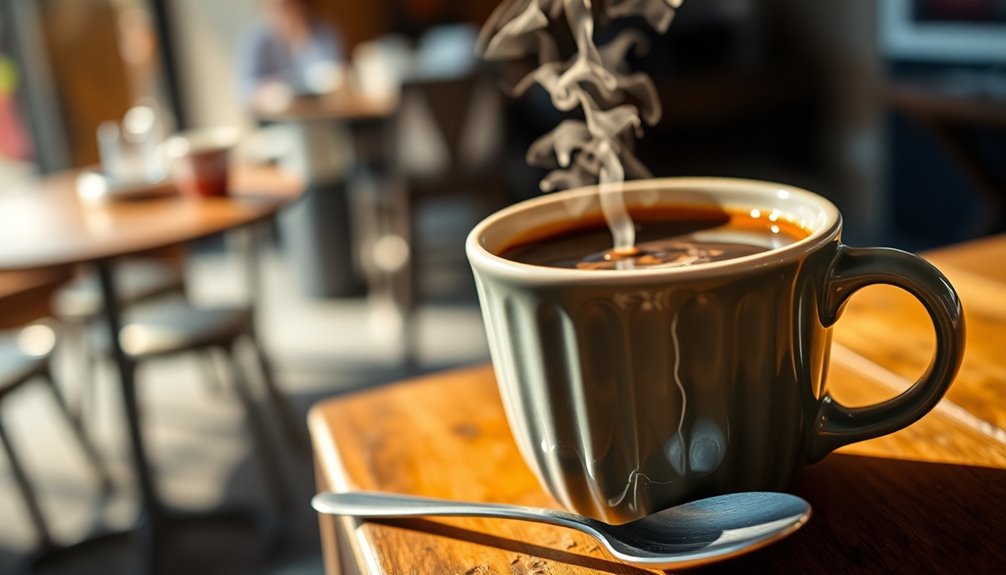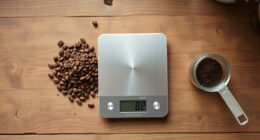Finding the perfect coffee-to-water ratio can elevate your brew for both taste and health. Start with common ratios: 1:15 for French press and 1:17 for pour-overs. Adjust based on your preferences—strong coffee lovers might enjoy a 1:10 ratio with a fine grind, while those seeking subtle flavors can opt for 1:18 or even 1:20 using coarser grinds. Precision is key, so consider using a kitchen scale for accurate measurements. Remember, the right grind size and brewing temperature also play vital roles. Curious about optimizing your brewing technique even further? There's much more to explore!
Key Takeaways
- Start with a coffee-to-water ratio of 1:15 for a balanced French press brew, adjusting to 1:14 for stronger flavors.
- Experiment with pour-over ratios around 1:16 to achieve smooth, consistent cups tailored to your taste preferences.
- Choose coarser grind for light, fruity flavors and finer grind for bold tastes while monitoring bitterness from over-extraction.
- Brew at temperatures between 195°F and 205°F to maximize flavor while avoiding under or over-extraction.
- Keep track of your ratio adjustments and preferences to refine your coffee brewing technique for optimal health and taste.
Understanding Coffee-to-Water Ratio

Have you ever wondered why the coffee-to-water ratio matters so much? It's all about achieving the right balance for your brew.
This ratio, which is the proportion of coffee grounds to water, directly influences the strength and flavor of your coffee. Typically expressed as grams of coffee to grams of water, common ratios range from 1:13 to 1:18, depending on the brewing method. For instance, manual pour-overs often use 1:17, while French presses may go for 1:15.
Factors like the type of beans, grind size, and personal taste preferences can all impact your ideal ratio. By understanding these nuances, you can customize your coffee to suit your palate perfectly. Additionally, using the recommended ratio helps ensure a well-balanced extraction and flavor profile.
Measuring Coffee and Water

Achieving the perfect coffee-to-water ratio hinges on precise measurements, making it vital to know how to measure both coffee and water accurately.
For the best results, use a kitchen scale to measure coffee and water in grams. A basic scale, measuring to the nearest gram, works well for most brewing methods. If you're brewing espresso, consider a scale that measures to the tenth of a gram for extra precision. This is particularly important because the coffee to water ratio can significantly impact the flavor and strength of your brew.
If you don't have a scale, you can use tablespoons, with a general ratio of 1 tablespoon of coffee to 4 ounces of water. However, this method lacks the accuracy of grams, leading to potential flavor variability.
Whichever method you choose, consistency is key to mastering your brew.
Ratios by Brewing Method

When it comes to brewing coffee, understanding the ideal ratios for different methods can significantly enhance your experience. Different brewing methods for coffee, such as French press, pour-over, and espresso, all require specific ratios of coffee to water in order to achieve the best flavor. For example, a typical ratio for pour-over coffee is 1:16, meaning one part coffee to sixteen parts water. These ratios can vary based on personal preference and the specific characteristics of the coffee being used, but having a general understanding of the ideal ratios for each brewing method can greatly improve the quality of the coffee you make at home.
For a French Press, use a 1:15 ratio—40 grams of coffee to 600 mL of water. If you prefer a stronger cup, adjust to 1:14. Coffee to water ratios can greatly affect the strength and flavor of your brew, so don't hesitate to experiment with different ratios.
In pour-over, stick to a 1:16 ratio, like 20 grams of coffee with 320 mL of water.
Automatic drip coffee typically uses a 1:17 ratio for a consistent brew.
The AeroPress is bold with a 1:10 ratio.
For cold brew, aim for 1:15 to 1:17.
Each method has its unique grind size and brewing technique, so be sure to match them to achieve the perfect cup every time.
Adjusting for Personal Taste

While brewing coffee, it's essential to tailor the water-to-coffee ratio to suit your personal taste.
Everyone's preferences vary, influenced by factors like genetics and mood. If you love strong, bold coffee, try a ratio of 1:10 or 1:12 with a finer grind. For a smooth, balanced cup, use 1:15 or 1:17 with a medium grind.
If you prefer light, fruity flavors, go for a higher ratio, like 1:18 or 1:20, and a coarser grind. Start within the standard 16-20:1 range, adjusting based on your taste. Additionally, remember that the origin influences flavor profiles significantly, which can guide your coffee selection.
Keep a log of your experiments to track what works. Ultimately, taste is subjective; trust your palate to find that perfect balance that satisfies you.
Impact of Grind Size and Temperature

Understanding the impact of grind size and temperature on your coffee can transform your brewing experience. A finer grind increases surface area, extracting more soluble compounds for a stronger flavor. However, if it's too fine, you risk bitterness from over-extraction. Conversely, a coarser grind results in a lighter taste, but too coarse can lead to under-extraction and weakness. Additionally, achieving a balance in extraction is crucial because small adjustments in grind size can significantly alter taste. Different methods require specific grind sizes, so adjust accordingly—espresso needs fine, while French press uses coarse. Temperature also plays a crucial role; aim for 195°F to 205°F. Higher temps extract more flavor but can cause bitterness, while lower temps lead to weak coffee. Balancing grind size and temperature is essential for achieving your desired flavor profile.
Tools for Precision Brewing

Achieving the perfect cup of coffee often hinges on using the right tools for precision brewing. Start with dosing tools, like dosing rings, to measure your coffee grounds accurately. Consider specialized brewing equipment such as the AeroPress, Hario V60, or Chemex for controlled brewing methods. Invest in a high-precision scale, like the Acaia Pearl, to ensure your coffee-to-water ratio is spot on. Additionally, incorporating espresso accessories designed for brewing precision can significantly elevate your coffee-making experience. Don't overlook adjustable brewing ratios and strength selection to customize each cup. For consistent milk frothing, opt for quality milk pitchers. Lastly, explore brewing precision kits that enhance accuracy and consistency. With these tools, you can fine-tune your brew for health and taste, ensuring every cup is just right. Moreover, understanding contrast ratios can help you appreciate the visual aspects of your coffee setup, enhancing your overall brewing experience.
Frequently Asked Questions
How Does Coffee Freshness Affect Brewing Ratios?
Coffee freshness plays a crucial role in determining your brewing ratios. When you use freshly roasted coffee, you'll often want to opt for a lower coffee-to-water ratio to prevent over-extraction.
In contrast, older coffee might require a stronger ratio to achieve a balanced flavor. Adjusting your grind size based on freshness also helps optimize extraction, ensuring you get the most out of your brew and enjoy a more vibrant taste.
Can I Reuse Coffee Grounds for a Second Brew?
You might think reusing coffee grounds is a good way to save, but it's not recommended.
The first brew extracts most of the flavors and caffeine, while a second brew mainly pulls out bitter acids. You'll end up with a cup that lacks the brightness and sweetness of the first.
Instead of reusing, consider composting those grounds or using them in your garden to make the most of them!
What Health Benefits Come From Proper Coffee Brewing?
When you brew coffee properly, you unlock numerous health benefits.
Using filtered methods, like pour-over, helps retain antioxidants and reduces unhealthy compounds, lowering your risk of heart disease. Moderate coffee consumption can decrease the likelihood of type 2 diabetes and certain cancers.
Plus, enjoying 1-4 cups daily is linked to better cardiovascular health.
With the right brewing techniques, you not only enhance flavor but also boost your overall well-being.
Does Water Quality Impact the Coffee Brewing Process?
Yes, water quality significantly impacts your coffee brewing process.
When you use water with the right mineral content, it enhances the extraction of flavors, leading to a richer cup. High levels of impurities can introduce off-flavors, while optimal pH and hardness levels balance acidity and bitterness.
How Can I Store Coffee Beans for Optimal Freshness?
To store coffee beans for optimal freshness, use an opaque, airtight container.
Keep them in a cool, dark place, ideally between 50°F to 70°F. Avoid moisture by steering clear of the fridge or freezer, as fluctuations can harm flavor.
Only grind what you need for each brew, and buy smaller batches to maintain freshness.
Conclusion
Finding the perfect coffee-to-water ratio can transform your brewing experience, enhancing both health benefits and taste. By understanding the fundamentals and experimenting with measurements based on your preferred method, you'll discover what suits your palate best. Don't forget to consider grind size and water temperature, as they play a crucial role in flavor extraction. With the right tools and a bit of practice, you'll brew a cup that's uniquely yours—delicious and satisfying every time.










